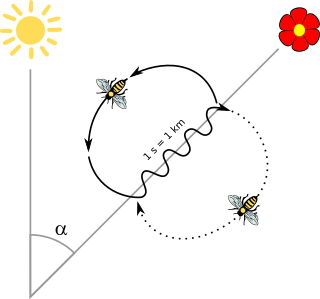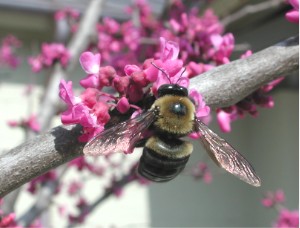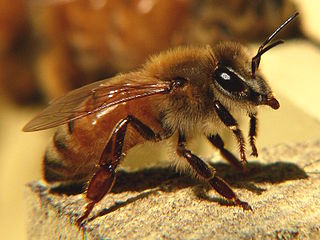
A honey bee is a eusocial flying insect within the genus Apis of the bee clade, all native to mainland Afro-Eurasia. After bees spread naturally throughout Africa and Eurasia, humans became responsible for the current cosmopolitan distribution of honey bees, introducing multiple subspecies into South America, North America, and Australia.

The Africanized bee, also known as the Africanized honey bee and colloquially as the "killer bee", is a hybrid of the western honey bee, produced originally by crossbreeding of the East African lowland honey bee (A. m. scutellata) with various European honey bee subspecies such as the Italian honey bee (A. m. ligustica) and the Iberian honey bee (A. m. iberiensis).
Classical conditioning is a behavioral procedure in which a biologically potent physiological stimulus is paired with a neutral stimulus. The term classical conditioning refers to the process of an automatic, conditioned response that is paired with a specific stimulus.

Bee learning and communication includes cognitive and sensory processes in all kinds of bees, that is the insects in the seven families making up the clade Anthophila. Some species have been studied more extensively than others, in particular Apis mellifera, or European honey bee. Color learning has also been studied in bumblebees.

The mushroom bodies or corpora pedunculata are a pair of structures in the brain of arthropods, including insects and crustaceans, and some annelids. They are known to play a role in olfactory learning and memory. In most insects, the mushroom bodies and the lateral horn are the two higher brain regions that receive olfactory information from the antennal lobe via projection neurons. They were first identified and described by French biologist Félix Dujardin in 1850.

Imidacloprid is a systemic insecticide belonging to a class of chemicals called the neonicotinoids which act on the central nervous system of insects. The chemical works by interfering with the transmission of stimuli in the insect nervous system. Specifically, it causes a blockage of the nicotinergic neuronal pathway. By blocking nicotinic acetylcholine receptors, imidacloprid prevents acetylcholine from transmitting impulses between nerves, resulting in the insect's paralysis and eventual death. It is effective on contact and via stomach action. Because imidacloprid binds much more strongly to insect neuron receptors than to mammal neuron receptors, this insecticide is more toxic to insects than to mammals.

Waggle dance is a term used in beekeeping and ethology for a particular figure-eight dance of the honey bee. By performing this dance, successful foragers can share information about the direction and distance to patches of flowers yielding nectar and pollen, to water sources, or to new nest-site locations with other members of the colony.

In classical conditioning, second-order conditioning or higher-order conditioning is a form of learning in which a stimulus is first made meaningful or consequential for an organism through an initial step of learning, and then that stimulus is used as a basis for learning about some new stimulus. For example, an animal might first learn to associate a bell with food, but then learn to associate a light with the bell. Honeybees show second-order conditioning during proboscis extension reflex conditioning.

Bees can suffer serious effects from toxic chemicals in their environments. These include various synthetic chemicals, particularly insecticides, as well as a variety of naturally occurring chemicals from plants, such as ethanol resulting from the fermentation of organic materials. Bee intoxication can result from exposure to ethanol from fermented nectar, ripe fruits, and manmade and natural chemicals in the environment.
Nosema ceranae is a microsporidian, a small, unicellular parasite that mainly affects Apis cerana, the Asiatic honey bee. Along with Nosema apis, it causes the disease nosemosis, the most widespread of the diseases of adult honey bees. N. ceranae can remain dormant as a long-lived spore which is resistant to temperature extremes and dehydration. This fungus has been shown to act in a synergistic fashion with diverse insecticides such as fipronil or neonicotinoids, by increasing the toxicity of pesticides for bees, leading to higher bee mortality. It may thus play an indirect role in colony collapse disorder. In addition, the interaction between fipronil and N. ceranae induces changes in male physiology leading to sterility.
A tremble dance is a dance performed by forager honey bees of the species Apis mellifera to recruit more receiver honey bees to collect nectar from the workers.

The East African lowland honey bee is a subspecies of the western honey bee. It is native to central, southern and eastern Africa, though at the southern extreme it is replaced by the Cape honey bee. This subspecies has been determined to constitute one part of the ancestry of the Africanized bees spreading through North and South America.

The western honey bee or European honey bee is the most common of the 7–12 species of honey bees worldwide. The genus name Apis is Latin for "bee", and mellifera is the Latin for "honey-bearing" or "honey carrying", referring to the species' production of honey.
The genetics of social behavior is an area of research that attempts to address the question of the role that genes play in modulating the neural circuits in the brain which influence social behavior. Model genetic species, such as D.melanogaster and Apis mellifera, have been rigorously studied and proven to be instrumental in developing the science of genetics. Many examples of genetic factors of social behavior have been derived from a bottom-up method of altering a gene and observing the change it produces in an organism. Sociogenomics is an integrated field that accounts for the complete cellular genetic complement of an organism from a top-down approach, accounting for all biotic influences that effect behavior on a cellular level.

Pain in invertebrates is a contentious issue. Although there are numerous definitions of pain, almost all involve two key components. First, nociception is required. This is the ability to detect noxious stimuli which evokes a reflex response that moves the entire animal, or the affected part of its body, away from the source of the stimulus. The concept of nociception does not necessarily imply any adverse, subjective feeling; it is a reflex action. The second component is the experience of "pain" itself, or suffering—i.e., the internal, emotional interpretation of the nociceptive experience. Pain is therefore a private, emotional experience. Pain cannot be directly measured in other animals, including other humans; responses to putatively painful stimuli can be measured, but not the experience itself. To address this problem when assessing the capacity of other species to experience pain, argument-by-analogy is used. This is based on the principle that if a non-human animal's responses to stimuli are similar to those of humans, it is likely to have had an analogous experience. It has been argued that if a pin is stuck in a chimpanzee's finger and they rapidly withdraw their hand, then argument-by-analogy implies that like humans, they felt pain. It has been questioned why the inference does not then follow that a cockroach experiences pain when it writhes after being stuck with a pin. This argument-by-analogy approach to the concept of pain in invertebrates has been followed by others.

Sniffer bees or sniffer wasps are insects in the order Hymenoptera that can be trained to perform a variety of tasks to detect substances such as explosive materials or illegal drugs, as well as some human and plant diseases. The sensitivity of the olfactory senses of bees and wasps in particular have been shown to rival the abilities of sniffer dogs, though they can only be trained to detect a single scent each.
The lateral horn is one of the two areas of the insect brain where projection neurons of the antennal lobe send their axons. The other area is the mushroom body. Several morphological classes of neurons in the lateral horn receive olfactory information through the projection neurons.
Queen mandibular pheromone, or QMP, is a honey bee pheromone produced by the queen and fed to her attendants who share it with the rest of the colony to give the colony the sense of belonging to the queen. Newly emerged queens produce very little QMP. By the sixth day they are producing enough to attract drones for mating. A laying queen makes twice that amount. Lack of QMP seems to attract robber bees. A study of foraging worker bees has suggested that foraging bees are not attracted to QMP.
Cognitive bias in animals is a pattern of deviation in judgment, whereby inferences about other animals and situations may be affected by irrelevant information or emotional states. It is sometimes said that animals create their own "subjective social reality" from their perception of the input. In humans, for example, an optimistic or pessimistic bias might affect one's answer to the question "Is the glass half empty or half full?"
Alison Ruth Mercer is a New Zealand zoologist based at the University of Otago, with a particular interest in the brain physiology of bees. She was elected a member of the National Academy of Sciences in 2022.











